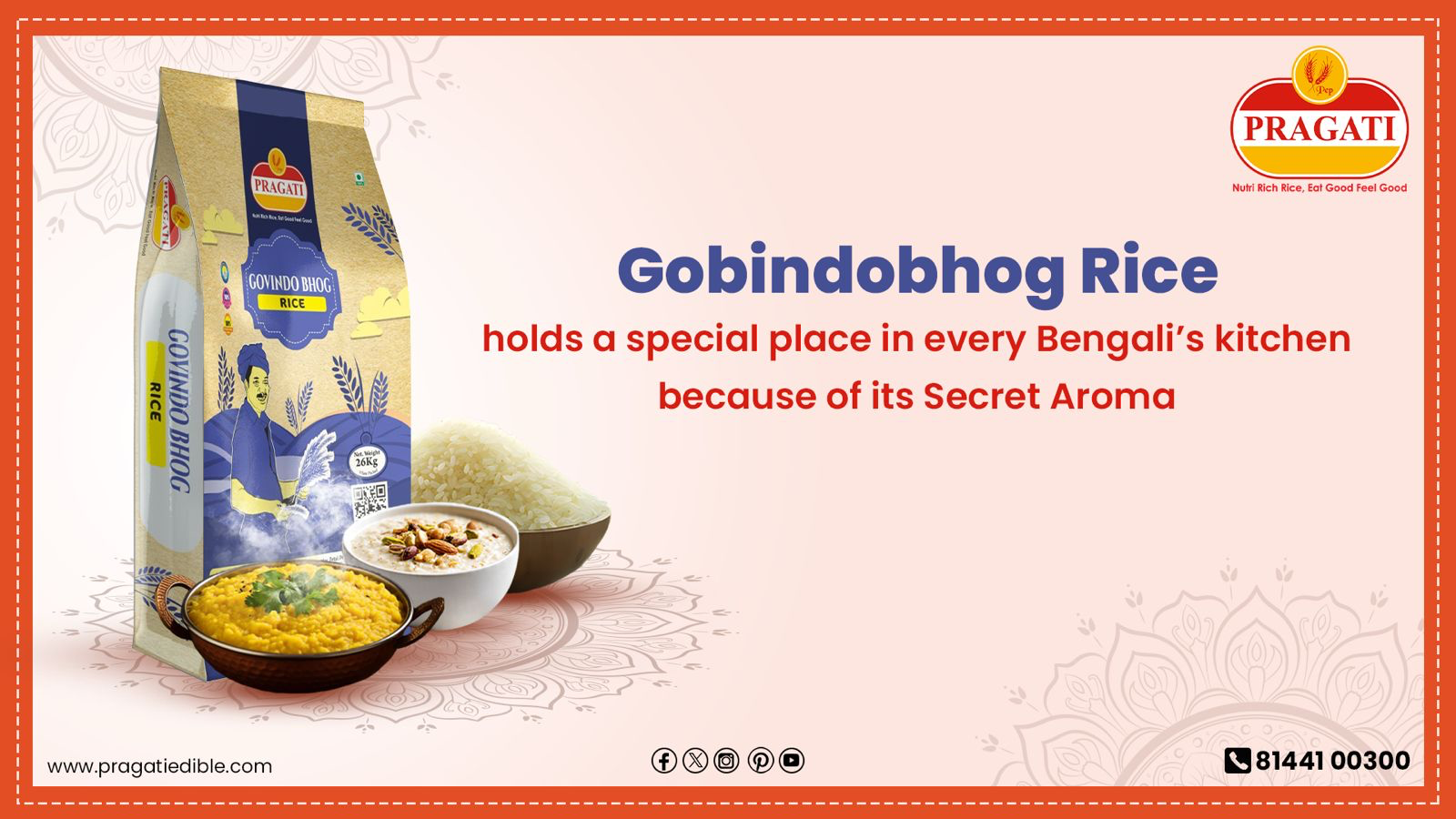Gobindobhog Rice holds a special place in every Bengali’s kitchen because of its Secret Aroma
4 November, 2025

In the heart of every Bengali kitchen lies a treasure that needs no introduction – Gobindobhog Rice. Known for its short grains, soft texture, and irresistible aroma, this traditional rice variety holds a centuries-old legacy. It is not just rice – it’s an emotion, a heritage, and a flavour that defines Bengal’s culinary soul.
From festive feasts to homely comfort meals, Gobindobhog rice quietly takes the centre stage, making every dish unforgettable. But what exactly makes this humble grain so special? Let’s explore the story behind Bengal’s most aromatic rice.
A Heritage Grain with a Divine Origin
The name Gobindobhog comes from two words – Gobindo (Lord Govinda or Krishna) and Bhog (offering to the deity). Historically, this rice was used as a sacred offering in temples across Bengal, especially in Jagannath Puri and Nabadwip. That’s how it earned the reputation of being the rice fit for the gods.
Over time, Gobindobhog became a part of Bengal’s everyday life – gracing the kitchen shelves of every household and forming the base of iconic dishes like khichuri, payesh, and pulao. It’s the rice that evokes nostalgia – reminding Bengalis of festive mornings, the scent of ghee, and the warmth of family gatherings.
The Secret of Its Unique Aroma
What truly distinguishes Gobindobhog rice from other varieties is its signature fragrance. The aroma is subtle yet unmistakable – rich, buttery, and naturally sweet.
This fragrance comes from the rice’s genetic makeup and the unique alluvial soil of the Burdwan and Hooghly districts of West Bengal, where it is primarily cultivated. The region’s fertile land, fed by the Ganges, provides the perfect balance of minerals and moisture. When combined with traditional farming techniques, this gives Gobindobhog rice its distinct aroma and soft texture.
Unlike basmati, which is long-grained and nutty, Gobindobhog is short, plump, and delicate – making it ideal for both sweet and savoury dishes. Its natural fragrance intensifies when cooked, filling the kitchen with a warm, appetising aroma that can only be described as Bengal itself.
A Culinary Star of Bengal
Bengal’s love affair with Gobindobhog rice can be seen in its wide use across traditional recipes. Each dish carries a story, and each story begins with this fragrant grain.
No Durga Puja or temple festival in Bengal is complete without the famous Bhog’er Khichuri. Prepared with Gobindobhog rice, moong dal, ghee, and vegetables, this dish represents purity and devotion. The rice’s soft grains and sweet aroma elevate the humble khichuri into something divine.
During celebrations like weddings and birthdays, Gobindobhog pulao takes centre stage. Cooked with ghee, raisins, cashews, and aromatic spices, it pairs beautifully with Bengali curries like Cholar Dal or Kosha Mangsho. The short-grain rice absorbs the flavours perfectly, giving each bite a melt-in-mouth experience.
When it comes to sweets, Payesh (rice pudding) made with Gobindobhog is pure bliss. Slow-cooked in milk and sugar, and garnished with cardamom and nuts, it’s a dish that celebrates life’s sweetest moments – birthdays, anniversaries, or simply the joy of togetherness.
Cultivation That Honours Tradition
Gobindobhog rice is cultivated mostly in small farms, using traditional organic methods passed down through generations. Farmers often refer to it as “White Gold of Bengal.”
Unlike hybrid or machine-processed rice, Gobindobhog is typically hand-harvested and sun-dried, retaining its natural oils and fragrance. This traditional approach ensures that every grain carries the purity and essence of Bengal’s fertile land.
The West Bengal government has even granted Geographical Indication (GI) status to Gobindobhog rice, protecting its authenticity and heritage. This recognition helps preserve its uniqueness against mass-produced alternatives and ensures fair value for the farmers who grow it.
Modern Kitchens, Traditional Aroma
In today’s fast-paced world, where convenience often overshadows culture, Gobindobhog rice continues to stand strong as a symbol of authenticity. Whether you’re cooking in a modern kitchen or a traditional clay stove, the aroma of Gobindobhog instantly connects you to your roots.
Chefs across India and abroad are rediscovering its potential – using it in fusion dishes, risottos, and desserts – yet, the magic remains the same. It’s the aroma that ties the past and present together.
Why Every Bengali Kitchen Needs Gobindobhog Rice
Aroma & Flavour: No other rice replicates its delicate sweetness and buttery aroma.
Texture: Perfectly soft and non-sticky when cooked – ideal for both sweets and savouries.
Tradition: A staple in rituals, festivals, and homely meals.
Nutrition: Naturally gluten-free, easy to digest, and full of energy.
Emotion: Every grain carries nostalgia, heritage, and the essence of Bengal.
More Than Just Rice – It’s a Feeling
For Bengalis, Gobindobhog rice isn’t just an ingredient – it’s a cultural heirloom. It has witnessed generations grow, festivals celebrated, and families come together. Its fragrance doesn’t just fill the air; it fills hearts with memories.
Even in today’s world of global cuisines and modern diets, Gobindobhog continues to hold its irreplaceable place as the soul of every Bengali kitchen, whispering stories of love, devotion, and belonging.
So the next time you open a pot of steaming rice and breathe in that warm, sweet aroma – remember, that’s not just rice cooking. That’s Bengal itself, simmering in tradition and love.
Discover the secret behind Gobindobhog Rice, Bengal's most aromatic grain. This ...
Rice plays a sacred role in Chhath Puja rituals, symbolizing purity, devotion, ...
Rice is at the heart of every Indian harvest festival, symbolising purity, prosp...
Cook authentic Bengali Muri Ghonto with fish head and Pragati Gobindobhog Rice. ...
Durga Puja celebrations are incomplete without Payesh - Bengal’s timeless fest...
Discover the authentic Kanika recipe from Odisha, a festive sweet pulao cooked w...